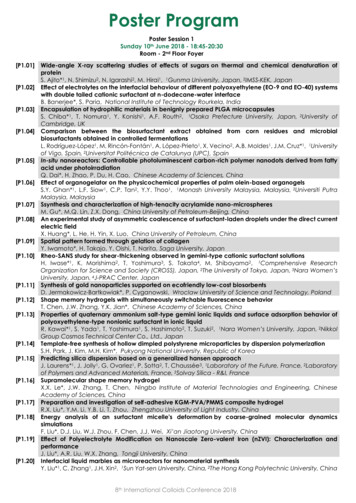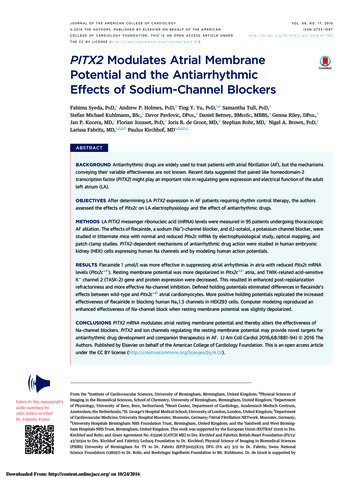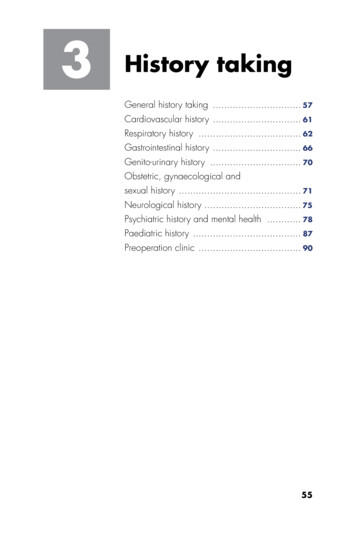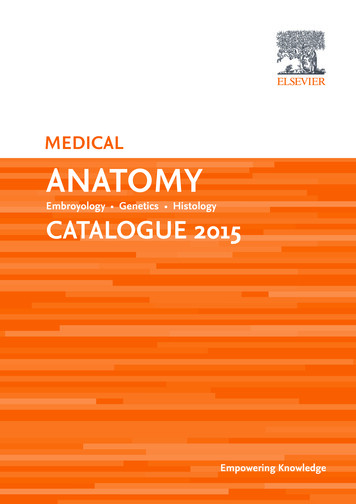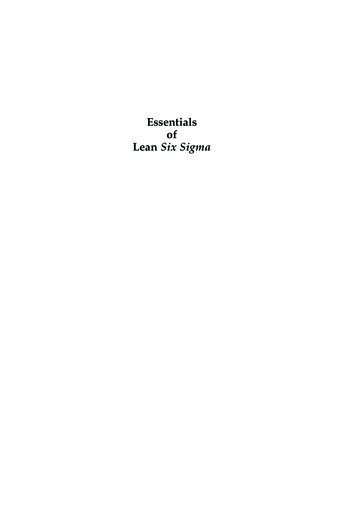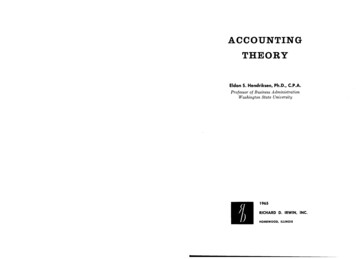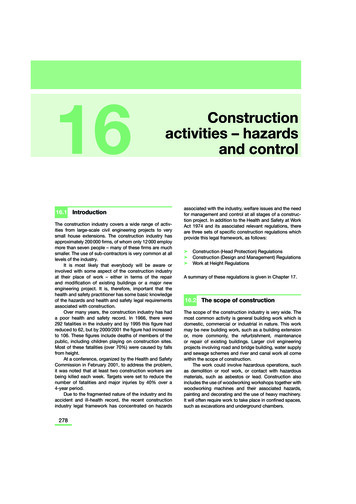
Transcription
16ConstructionConstructionactivities – hazardsactivities – hazardsand controland control16.1 IntroductionThe construction industry covers a wide range of activities from large-scale civil engineering projects to verysmall house extensions. The construction industry hasapproximately 200 000 firms, of whom only 12 000 employmore than seven people – many of these firms are muchsmaller. The use of sub-contractors is very common at alllevels of the industry.It is most likely that everybody will be aware orinvolved with some aspect of the construction industryat their place of work – either in terms of the repairand modification of existing buildings or a major newengineering project. It is, therefore, important that thehealth and safety practitioner has some basic knowledgeof the hazards and health and safety legal requirementsassociated with construction.Over many years, the construction industry has hada poor health and safety record. In 1966, there were292 fatalities in the industry and by 1995 this figure hadreduced to 62, but by 2000/2001 the figure had increasedto 106. These figures include deaths of members of thepublic, including children playing on construction sites.Most of these fatalities (over 70%) were caused by fallsfrom height.At a conference, organized by the Health and SafetyCommission in February 2001, to address the problem,it was noted that at least two construction workers arebeing killed each week. Targets were set to reduce thenumber of fatalities and major injuries by 40% over a4-year period.Due to the fragmented nature of the industry and itsaccident and ill-health record, the recent constructionindustry legal framework has concentrated on hazardsassociated with the industry, welfare issues and the needfor management and control at all stages of a construction project. In addition to the Health and Safety at WorkAct 1974 and its associated relevant regulations, thereare three sets of specific construction regulations whichprovide this legal framework, as follows: Construction (Head Protection) Regulations Construction (Design and Management) Regulations Work at Height RegulationsA summary of these regulations is given in Chapter 17.16.2 The scope of constructionThe scope of the construction industry is very wide. Themost common activity is general building work which isdomestic, commercial or industrial in nature. This workmay be new building work, such as a building extensionor, more commonly, the refurbishment, maintenanceor repair of existing buildings. Larger civil engineeringprojects involving road and bridge building, water supplyand sewage schemes and river and canal work all comewithin the scope of construction.The work could involve hazardous operations, suchas demolition or roof work, or contact with hazardousmaterials, such as asbestos or lead. Construction alsoincludes the use of woodworking workshops together withwoodworking machines and their associated hazards,painting and decorating and the use of heavy machinery.It will often require work to take place in confined spaces,such as excavations and underground chambers.278CH016.indd 2787/18/07 5:30:44 PM
Construction activities – hazards and controlFinally, at any given time, there are many youngpeople receiving training on site in the various construction trades. These trainees need supervision andstructured training programmes.16.3 Construction hazards and controlsThe Construction (Design and Management (CDM)Regulations 2007 deal with many of the hazards likelyto be found on a building site. In addition to these specific hazards, there will be the more general hazards (e.g.working at height, manual handling, electricity, noise,etc.) which have been discussed in more detail in earlierchapters. The hazards and controls identified in the CDM2007 and Work at Height Regulations are as follows.16.3.1Safe place of workSafe access to and egress from the site and the individual places of work on the site are fundamental toa good health and safety environment. This clearlyrequires that all ladders, scaffolds, gangways, stairways and passenger hoists are safe for use. It furtherrequires that all excavations are fenced, the site is tidyand proper arrangements are in place for the storage ofmaterials and the disposal of waste. The site needs tobe adequately lit and secured against intruders, particularly children, when it is unoccupied. Such security willinclude: secure and locked gates with appropriate noticesposted a secure and undamaged perimeter fence withappropriate notices posted all ladders either stored securely or boarded acrosstheir rungs all excavations covered all mobile plant immobilized and fuel removed,where practicable, and services isolated secure storage of all inflammable and hazardoussubstances visits to local schools to explain the dangers presenton a construction site. This has been shown toreduce the number of child trespassers if unauthorized entry persists, then security patrolsand closed circuit television may need to beconsidered.16.3.2Work at heightWork at height accounts for about 50–60 deaths – morethan any other workplace activity – and 4000 injurieseach year. This is being addressed by the introductionof the Work at Height Regulations which apply to alloperations carried out at height, not just constructionwork, so that they are also relevant to, for example, window cleaning, tree surgery, maintenance work at heightand the changing of street lamps. The Work at HeightRegulations affect approximately 3 m workers whereworking at height is essential to their work.The Work at Height Regulations have no minimumheight requirement for work at height. They include allwork activities where there is a need to control a riskof falling a distance liable to cause personal injury. Thisis regardless of the work equipment being used, theduration of the work at height involved, or the height atFigure 16.1 Secure site access gate.279CH016.indd 2797/18/07 5:30:45 PM
Introduction to Health and Safety at Workwhich the work is performed. It includes access to andegress from a place of work. It would therefore include: Working on a scaffold or from a mobile elevatedwork platform (MEWP) Sheeting a lorry or dipping a road tanker Working on the top of a container in docks or on aship or storage area Tree surgery and other forestry work at height Using cradles or rope for access to a building orother structure like a ship under repair Climbing permanent structures like a gantry or telephone pole Working near an excavation area or cellar opening ifa person could fall into it and be injured Painting or pasting and erecting bill posters atheight Work on staging or trestles. e.g. for filming or events Using a ladder/stepladder or kick stool for shelf filling, window cleaning and the like Using manriding harnesses in ship repair, off-shoreor steeple jack work Working in a mine shaft or chimney Work carried out at a private house by a personemployed for the purpose, e.g. painter and decorator (but not if the private individual carries out workon their own home). the employer shall take suitable and sufficient measures to minimize the distance and consequences ofa fall (collective measures, e.g. air bags or safetynets, must take precedence over individual measures, e.g. safety harnesses).The risk assessment and action required to control risksfrom using a kick stool to collect books from a shelfshould be simple (e.g. not overloading, not overstretching, etc). However, the action required for a complexconstruction project would involve significantly greaterconsideration and assessment of risk. A summary of theRegulations is given in Chapter 17.16.3.3Protection against falls fromwork at heightThe Work at Height Regulations require that guard railson scaffolds are at a minimum of 950 mm and the maximum unprotected gap between the toe and guard railof a scaffold is 470 mm. This implies the use of an intermediate guard rail although other means, such as additional toe boards or screening, may be used. It alsospecifies requirements for personal suspension equipment and means of arresting falls (such as safety nets).When working at height, a hierarchy of measuresshould then be followed, to prevent falls from occurring.These measures are:However it would not include: Slips trips and falls on the same level Falls on permanent stairs if there is no structural ormaintenance work being done Work in the upper floor of a multi storey buildingwhere there is no risk of falling (except separateactivities like using a stepladder).At the centre of the regulations (Regulation 6), theemployer is expected to apply a three stage hierarchy toall work which is to be carried out at height. The threesteps are the avoidance of work at height, the preventionof workers from falling and the mitigation of the effect onworkers of falls should they occur.The regulations require that: work is not carried out at height when it is reasonably practicable to carry the work out safely otherthan at height (e.g. the assembly of componentsshould be done at ground level) when work is carried out at height, the employershall take suitable and sufficient measures to prevent, so far as is reasonably practicable, any personfalling a distance liable to cause injury (e.g. the useof guard rails) avoid working at height, lf possible the provision of a properly constructed working platform, complete with toe boards and guard-rails if this is not practicable or where the work is of shortduration, suspension equipment should be used andonly when this is impracticable collective fall arrest equipment (air bags or safetynets) may be used. where this is not practicable individual fall restrainers (safety harnesses) should be used only when none of the above measures are practicable, should ladders of step ladders be considered.16.3.4Fragile roofs and surfacesWork on or near fragile surfaces is also covered by theWork at Height Regulations (see summary in Chapter17). Roof work, particularly work on pitched roofs, ishazardous and requires a specific risk assessment andmethod statement (see later under the managementof construction activities for a definition) prior to thecommencement of work. Particular hazards are fragileroofing materials, including those materials which deteriorate and become more brittle with age and exposureto sunlight, exposed edges, unsafe access equipment280CH016.indd 2807/18/07 5:30:49 PM
Construction activities – hazards and controlFigure 16.2 Proper precautions must always be taken when working on or near fragile roofs.and falls from girders, ridges or purlins. There must besuitable means of access such as scaffolding, laddersand crawling boards. Suitable barriers, guard rails orcovers where people work near to fragile materials androof lights. Suitable warning signs indicating that a roofis fragile, should be on display at ground level.There are other hazards associated with roof work –overhead services and obstructions, the presence ofasbestos or other hazardous substances, the use ofequipment such as gas cylinders and bitumen boilersand manual handling hazards.It is essential that only trained and competentpersons are allowed to work on roofs and that they wearfootwear having a good grip. It is a good practice toensure that a person does not work alone on a roof.16.3.5Protection against falling objectsAlso now covered by the Work at Height Regulations(see summary of Chapter 17). Both construction workersand members of the public need to be protected fromthe hazards associated with falling objects. Both groupsshould be protected by the use of covered walkways orsuitable netting to catch falling debris. Waste materialshould be brought to ground level by the use of chutesor hoists. Waste should not be thrown and only minimal quantities of building materials should be stored onworking platforms. The Construction (Head Protection)Regulations 1989 virtually mandates employers to supply head protection (hard hats) to employees wheneverthere is a risk of head injury from falling objects. (Sikhswearing turbans are exempted from this requirement.)The employer is also responsible for ensuring that hardhats are properly maintained and replaced when theyare damaged in any way. Self-employed workers mustsupply and maintain their own head protection. Visitorsto construction sites should always be supplied withhead protection and mandatory head protection signsdisplayed around the site.16.3.6DemolitionDemolition is one of the most hazardous constructionoperations and is responsible for more deaths and majorinjuries than any other activity. The management of demolition work is controlled by the Construction (Designand Management) Regulations and requires a planningsupervisor and a health and safety plan (see the nextsection of this chapter).The principal hazards associated with demolitionwork are: falls from height or on the same levelfalling debrispremature collapse of the structure being demolisheddust and fumesthe silting up of drainage systems by dustthe problems arising from spilt fuel oilsmanual handlingpresence of asbestos and other hazardoussubstancesnoise and vibration from heavy plant and equipmentelectric shockfires and explosions from the use of flammable andexplosive substancessmoke from burning waste timberpneumatic drills and power toolsthe existence of services, such as electricity, gasand watercollision with heavy plant, andplant and vehicles overturning.Before any work is started, a full site investigation mustbe made by a competent person to determine the281CH016.indd 2817/18/07 5:30:50 PM
Introduction to Health and Safety at Workhazards and associated risks which may affect thedemolition workers and members of the public whomay pass close to the demolition site. The investigationshould cover the following topics: construction details of the structures or buildings tobe demolished and those of neighbouring structureso
Construction activities – hazards and control 281 and falls from girders, ridges or purlins. There must be suitable means of access such as scaffolding, ladders and crawling boards. Suitable barriers, guard rails or covers where people work near to fragile materials and roof lights. Suitable warning signs indicating that a roof is fragile, should be on display at ground level. There are .

